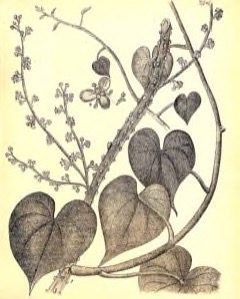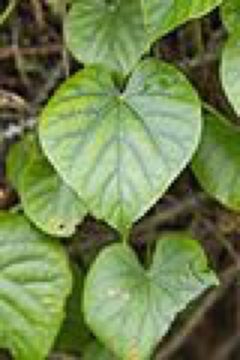 |
|
http://www.edibleplants.org |
 |
| Marcin Konsek / Wikimedia Commons |
Translate this page:
Summary
Tinospora crispa is a deciduous, dioecious, climbing shrub about 15 m long with stems of up to 1 cm thick and aerial roots. It can be found in East Asia. No plant part is edible but it is highly valued as a medicinal plant. It is used in the treatment of fevers, stomach problems, indigestion, diarrhea, flatulence in children, tropical ulcers, external parasites, itches, diabetes, high blood pressure, abdominal pain, cholera, jaundice, and wounds.
Physical Characteristics

 Tinospora crispa is a deciduous Climber growing to 10 m (32ft) by 0.3 m (1ft in) at a fast rate.
Tinospora crispa is a deciduous Climber growing to 10 m (32ft) by 0.3 m (1ft in) at a fast rate.
See above for USDA hardiness. It is hardy to UK zone 10. The plant is not self-fertile.
Suitable for: light (sandy), medium (loamy) and heavy (clay) soils and prefers well-drained soil. Suitable pH: mildly acid, neutral and basic (mildly alkaline) soils. It cannot grow in the shade. It prefers dry or moist soil.
UK Hardiness Map
US Hardiness Map
Synonyms
Menispermum crispum L. Tinospora gibbericaulis Hand.-Mazz. Tinospora mastersii Diels Tinospora rumph
Plant Habitats
Edible Uses
Edible Parts:
Edible Uses: Drink
None known
References More on Edible Uses
Medicinal Uses
Plants For A Future can not take any responsibility for any adverse effects from the use of plants. Always seek advice from a professional before using a plant medicinally.
Antidiarrhoeal Antirheumatic Cancer Carminative Cholera Febrifuge Hypotensive Malaria
Parasiticide Skin Tonic Vermifuge Vulnerary
Considered to be a universal medicine by local people in the Philippines who give it the name 'makabuhai', which means 'to give life'[582 ]. The plant is commonly prescribed as a decoction or in powder form in the treatment of fevers, stomach trouble, indigestion, and diarrhoea. It is the basis of a popular preparation, which is used as a cordial, a tonic, or an ingredient in cocktails[582 ]. A preparation made with coconut oil is an effective cure for rheumatism and is also used in the treatment of flatulence in children[582 ]. This preparation is made by chopping the stem into pieces 2 - 5cm long and placing them in a jar with coconut oil,. This jar is then left out in a sunny position to 'cook' and is then stored for 12 months until it is ready to use[582 ]. The stem is antimalarial, parasiticide, tonic and vulnerary[582 ]. It is taken internally in the treatment of fevers[582 ]. Taken externally, a decoction of the stem is considered an effective cure if used as a wash for tropical ulcers, external parasites, and is also an excellent vulnerary for itches, ordinary and cancerous wounds[582 ]. An infusion of the stem is drunk in Malaysia and Indonesia as a vermifuge and of the whole plant to treat cholera; it is also used to treat diabetes mellitus[310 ]. Externally it is applied against scabies and to heal wounds. In Brunei, the plant is used in the treatment of high blood pressure, diabetes and to relieve abdominal pains. In Indo-China, an infusion of the stem is drunk to treat fever (also when caused by malaria) and jaundice. Powdered stems are used to fatten horses and cattle by stimulating their appetite. Tinospora crispa is a very commonly used medicinal plant in the Philippines. In Thailand, an infusion from the stem is used to treat jaundice, cholera, malaria, and against worms in children[310 ].
References More on Medicinal Uses
The Bookshop: Edible Plant Books
Our Latest books on Perennial Plants For Food Forests and Permaculture Gardens in paperback or digital formats.

Edible Tropical Plants
Food Forest Plants for Hotter Conditions: 250+ Plants For Tropical Food Forests & Permaculture Gardens.
More

Edible Temperate Plants
Plants for Your Food Forest: 500 Plants for Temperate Food Forests & Permaculture Gardens.
More

More Books
PFAF have eight books available in paperback and digital formats. Browse the shop for more information.
Shop Now
Other Uses
Parasiticide
Agroforestry Uses: Some species in this genus are the larval hosts of fruit-piercing noctuid moths that cause significant damage to crops of Citrus (particularly Mandarins) and Dimocarpus longan (Longan) in Thailand[266 ]. Other Uses None known
Special Uses
References More on Other Uses
Cultivation details
A dioecious species, both male and female forms need to be grown if seed is required. The female form is much rarer than the male, suggesting vegetative propagation of male plants for medicinal purposes[266 ].
References Carbon Farming Information and Carbon Sequestration Information
Temperature Converter
Type a value in the Celsius field to convert the value to Fahrenheit:
Fahrenheit:
The PFAF Bookshop
Plants For A Future have a number of books available in paperback and digital form. Book titles include Edible Plants, Edible Perennials, Edible Trees,Edible Shrubs, Woodland Gardening, and Temperate Food Forest Plants. Our new book is Food Forest Plants For Hotter Conditions (Tropical and Sub-Tropical).
Shop Now
Plant Propagation
Seed - Cuttings - easy, the stems naturally produce aerial roots.
Other Names
If available other names are mentioned here
akar seruntum, amrithaballi, caulis tinosporae, galo, geta kinda / tiththa kinda, giloy, patawali, putawali, tinospora stem.
Native Range
TEMPERATE ASIA: China (Guangdong Sheng, Guangxi Zhuangzu Zizhiqu, Yunnan Sheng) TROPICAL ASIA: India, Sri Lanka, Cambodia, Laos, Thailand, Vietnam, Indonesia, Malaysia, Philippines
Weed Potential
Right plant wrong place. We are currently updating this section.
Please note that a plant may be invasive in one area but may not in your area so it's worth checking.
Conservation Status
IUCN Red List of Threatened Plants Status : This taxon has not yet been assessed

Growth: S = slow M = medium F = fast. Soil: L = light (sandy) M = medium H = heavy (clay). pH: A = acid N = neutral B = basic (alkaline). Shade: F = full shade S = semi-shade N = no shade. Moisture: D = dry M = Moist We = wet Wa = water.
Now available:
Food Forest Plants for Mediterranean Conditions
350+ Perennial Plants For Mediterranean and Drier Food Forests and Permaculture Gardens.
[Paperback and eBook]
This is the third in Plants For A Future's series of plant guides for food forests tailored to
specific climate zones. Following volumes on temperate and tropical ecosystems, this book focuses
on species suited to Mediterranean conditions—regions with hot, dry summers and cool, wet winters,
often facing the added challenge of climate change.
Read More
Expert comment
Author
(L.) Hook.f. & Thomson
Botanical References
Links / References
For a list of references used on this page please go here
A special thanks to Ken Fern for some of the information used on this page.
Readers comment
| Add a comment |
|
If you have important information about this plant that may help other users please add a comment or link below. Only comments or links that are felt to be directly relevant to a plant will be included. If you think a comment/link or information contained on this page is inaccurate or misleading we would welcome your feedback at [email protected]. If you have questions about a plant please use the Forum on this website as we do not have the resources to answer questions ourselves.
* Please note: the comments by website users are not necessarily those held by PFAF and may give misleading or inaccurate information.
To leave a comment please Register or login here All comments need to be approved so will not appear immediately.
|
Subject : Tinospora crispa
|
|
|
|